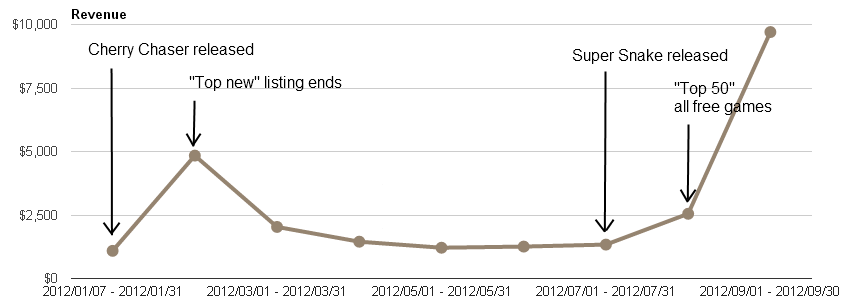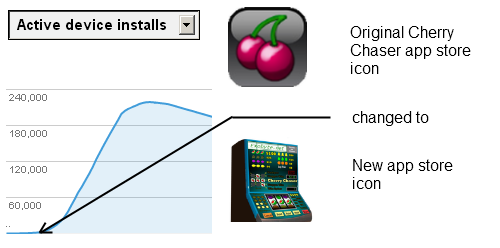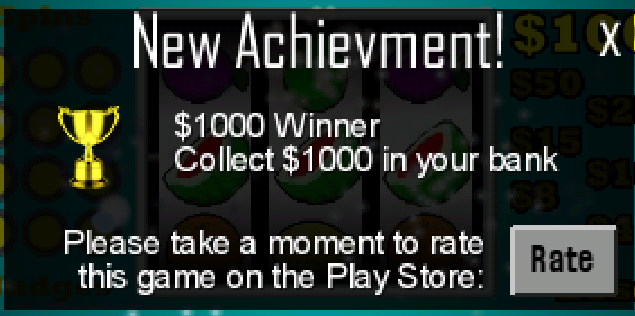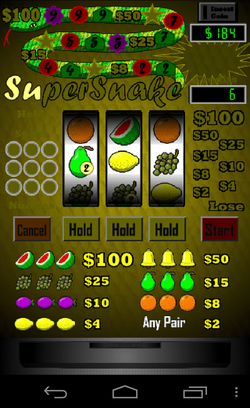In January I released Cherry Chaser slot machine on to the Android market. The game was very simple back then with many of its features still missing. I released it to "test the water" with the idea that it's best to just get something released and then fix issues and add features as necessary.
Fast forward eight months and I now have my second game doing very well and between both games I'm currently earning more through mobile advertising than I do in my day job. Cherry Chaser now has 800k user installs and Super Snake is up to 200k after 2 months on the market.
In this post I am going to recap my Android game development journey and summarise my experiences and the lessons that I have learned.
Fast forward eight months and I now have my second game doing very well and between both games I'm currently earning more through mobile advertising than I do in my day job. Cherry Chaser now has 800k user installs and Super Snake is up to 200k after 2 months on the market.
In this post I am going to recap my Android game development journey and summarise my experiences and the lessons that I have learned.
A graph is as good as a thousand words and here you can see a pretty good overview of my journey in terms of revenue from my games over the past eight months. There are a few things that need to be explained further. The profile of revenue immediately after each release is completely different for example. I have some ideas as to why that is the case and I'll get to that later.
From the graph above it looks like Cherry Chaser was immediately successful but that wasn't really the case. For a while it looked as though the game would stay in relative obscurity. To make it noticeable I had to make a good first impression and that meant doing some work on the app store icon.
From the graph above it looks like Cherry Chaser was immediately successful but that wasn't really the case. For a while it looked as though the game would stay in relative obscurity. To make it noticeable I had to make a good first impression and that meant doing some work on the app store icon.
When first released, Cherry Chaser had a very anonymous icon on the store. The "pair of cherries" icon could represent any number of things and gave no idea as to what the game was about. When somebody browsed the Google Play store pretty much all they saw was that icon, they may not even register the app's name whilst scrolling past. With the anonymous cherries icon my app stayed in obscurity with hardly any downloads even though it was well placed in the "new games" list in the Cards and casino games category.
I realised quite quickly that I needed a better icon, and I needed one quickly whilst in the golden 30 days during which games are displayed on the "top new games" listings. I chose an icon that showed the potential player exactly what the game was about at the briefest of glances. Anybody who has seen the type of fruit machine that my games emulate will immediately recognise the new app store icon. I changed the icon and downloads began to soar.
Just how successful it was in terms of number of downloads was quite a surprise. It very quickly went into the hundreds of thousands of active installations. I put this success down to two factors:
1. Games are generally more visible in the cards and casino games section than the other categories on Google Play. There is less competition and it's fairly easy to get into the top ten new games.
2. Cherry Chaser filled a niche within the slot machine genre that had not yet been filled in the mobile games market. Cherry Chaser simulates a European pub style fruit machine. Every other slot machine on the market seemed to simulate five reel "Las Vegas" style slots which offer very limited entertainment value other than gambling for more money.
After the initial surge of interest generated by the interesting new icon on the app store, the next phase of Cherry Chaser's life cycle was a gentle but inexorable slide back down into obscurity. This slide was helped along by a number of bad customer ratings and the simple fact that there was nothing particularly in the game to hold people's attention. The very first version of Cherry Chaser released did not even save the player's credits between game sessions.
Addressing these issues became the priority for new versions of the game. Over the next few weeks I added the ability to save player preferences and credits between sessions, I added in achievements to give the player longer term goals and I also added in a request for players to rate the game after winning an achievement.
I realised quite quickly that I needed a better icon, and I needed one quickly whilst in the golden 30 days during which games are displayed on the "top new games" listings. I chose an icon that showed the potential player exactly what the game was about at the briefest of glances. Anybody who has seen the type of fruit machine that my games emulate will immediately recognise the new app store icon. I changed the icon and downloads began to soar.
Just how successful it was in terms of number of downloads was quite a surprise. It very quickly went into the hundreds of thousands of active installations. I put this success down to two factors:
1. Games are generally more visible in the cards and casino games section than the other categories on Google Play. There is less competition and it's fairly easy to get into the top ten new games.
2. Cherry Chaser filled a niche within the slot machine genre that had not yet been filled in the mobile games market. Cherry Chaser simulates a European pub style fruit machine. Every other slot machine on the market seemed to simulate five reel "Las Vegas" style slots which offer very limited entertainment value other than gambling for more money.
After the initial surge of interest generated by the interesting new icon on the app store, the next phase of Cherry Chaser's life cycle was a gentle but inexorable slide back down into obscurity. This slide was helped along by a number of bad customer ratings and the simple fact that there was nothing particularly in the game to hold people's attention. The very first version of Cherry Chaser released did not even save the player's credits between game sessions.
Addressing these issues became the priority for new versions of the game. Over the next few weeks I added the ability to save player preferences and credits between sessions, I added in achievements to give the player longer term goals and I also added in a request for players to rate the game after winning an achievement.
The request to rate the game was particularly effective and raised the average rating from 3.8 (at it's lowest) to about 4.5 where it has remained since. I think the timing of the request, just after the player had been given an award, was also helpful in getting good ratings. Before adding this feature it seemed a lot of people only rated the game if they had had a bad experience with it.
As effective as these updates were, they came too late to capitalise on the time when Cherry Chaser was trending highly in the Play store. Without the achievements to encourage long term playability, a large number of the hundreds of thousands of people that downloaded the game in those few days then uninstalled it again quite soon afterwards.
Another feature I added at this point was the ability to purchase a premium version of the game that removed the banner advert from the game and replaced it with an animated coin tray. I did this largely in response to users that messaged me to tell me that they would pay for a version without adverts. As it has turned out, this feature has not particularly successful. The number of users that buy the game compared to those that download it for free is about one in a thousand and income from the paid apps is about 2-3% of what I get through advertising.
With these lessons learned I began work on Super Snake. This time I would have all the features in place to encourage player retention and replayability from step one. I also had some ideas that would make the new game more addictive than Cherry Chaser.
As effective as these updates were, they came too late to capitalise on the time when Cherry Chaser was trending highly in the Play store. Without the achievements to encourage long term playability, a large number of the hundreds of thousands of people that downloaded the game in those few days then uninstalled it again quite soon afterwards.
Another feature I added at this point was the ability to purchase a premium version of the game that removed the banner advert from the game and replaced it with an animated coin tray. I did this largely in response to users that messaged me to tell me that they would pay for a version without adverts. As it has turned out, this feature has not particularly successful. The number of users that buy the game compared to those that download it for free is about one in a thousand and income from the paid apps is about 2-3% of what I get through advertising.
With these lessons learned I began work on Super Snake. This time I would have all the features in place to encourage player retention and replayability from step one. I also had some ideas that would make the new game more addictive than Cherry Chaser.
At the beginning of August I released Super Snake on the Play Store. Uptake was slow compared to the meteoric rise in uploads that I experienced with Cherry Chaser, but steady and still very healthy. I believe the slower uptake was due to the Play Store icon being so similar to the one for Cherry Chaser that many people who had already tried the first game disregarded the new game as more of the same.
Despite the slower uptake from users, the revenue figures show that the users that did try out Super Snake played it a lot more than players of Cherry Chaser. That is due to Super Snake have a slightly more addictive hook for the gameplay and also due to the game having achievements that the player can strive for built in from the start. Interestingly, releasing Super Snake also gave Cherry Chaser a new lease of life and downloads and revenues picked up on that game as well.
In terms of revenue it looks like the strategy I've adopted has worked very well. For about a week around the beginning of October the combined advertising revenue from both games peaked at an average of $400 per day. That was about $300 from Super Snake and $100 from Cherry Chaser. Revenue is falling again now but will be quite substantial for some time. It would certainly be enough for me to write games full time if I didn't have other commitments.
Despite the slower uptake from users, the revenue figures show that the users that did try out Super Snake played it a lot more than players of Cherry Chaser. That is due to Super Snake have a slightly more addictive hook for the gameplay and also due to the game having achievements that the player can strive for built in from the start. Interestingly, releasing Super Snake also gave Cherry Chaser a new lease of life and downloads and revenues picked up on that game as well.
In terms of revenue it looks like the strategy I've adopted has worked very well. For about a week around the beginning of October the combined advertising revenue from both games peaked at an average of $400 per day. That was about $300 from Super Snake and $100 from Cherry Chaser. Revenue is falling again now but will be quite substantial for some time. It would certainly be enough for me to write games full time if I didn't have other commitments.
The next step of my journey with these two games is to give them some updated professional grade graphics. I used some of the revenue from Cherry Chaser to hire a freelance graphics designer using odesk. He's created some fantastic graphics for me and I'm currently in the process of incorporating them into the games. Once both games are update with these graphics I will be content to leave them and move on to other projects.
As a final note, if you're reading this and thinking that you would like to try your hand at Android games programming, save yourself a tonne of time and try out the LibGDX game library. I tried two other game libraries before finding LibGDX and both resulted in false starts where I ran into the limitations of those libraries. LibGDX is free to use and is created by Mario Zechner of Badlogic games. Mario is also the author of "Beginning Android Games" published by Apress. I can thoroughly recommend that book as a great introduction to the creation of a game and game engine.
As a final note, if you're reading this and thinking that you would like to try your hand at Android games programming, save yourself a tonne of time and try out the LibGDX game library. I tried two other game libraries before finding LibGDX and both resulted in false starts where I ran into the limitations of those libraries. LibGDX is free to use and is created by Mario Zechner of Badlogic games. Mario is also the author of "Beginning Android Games" published by Apress. I can thoroughly recommend that book as a great introduction to the creation of a game and game engine.







 RSS Feed
RSS Feed